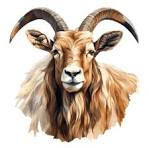Change in Population Growth.
The data in two years (2015-2017) have been collected for Astor Markhor from five different districts of Gilgit
Baltistan. An enumeration of 1087 animal species in 15
community controlled hunting areas have been found. It
includes 24%, 36% 21% and 19% males, females,
youngsters and toddlers respectively. Generally, provinces
contain a total population growth of about 0.13 animals per
kilometer.
The population growth and density of Markhor
species in several areas was recorded, rstly kargah
became at the peak point having 211 species, then Bunji
having 187 number of species. There are 119 species in
doyan, 75 range in sakwar-jutial-barmas and 74 in tangir
area etc. In Pakistan, there are a total ve subspecies
of Markhor. One subspecies is so-called as chiltan Markhor
commonly known as wild goat. Remaining four subspecies
are straight horned Markhor (SHM) such as Kabul and
Suleiman Marhor and two are horned Markhor (FHM) as
Astor and Kashmir Markhor. A total number of FHM was
approximately counted as 1500, while SHM was lower than
2000 species. Markhor species have versatile habitats
that have the ability to live in temperature ranges from 40
plus. Due to community based hunting programs,
Markhor conservative status became endangered in 2015,
and changed to near threatened species in 2018. In Chitral
Gol national park, the population growth of Markhor is
increasing annually. In 1990, only 154 species was found but
number of species increase in 2006 survey up to 612
species.




Comments
Post a Comment